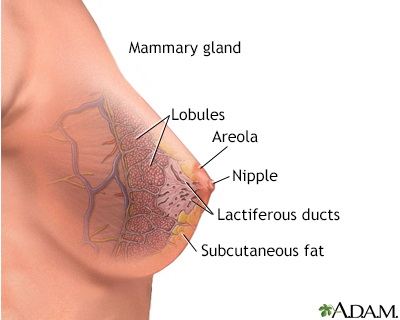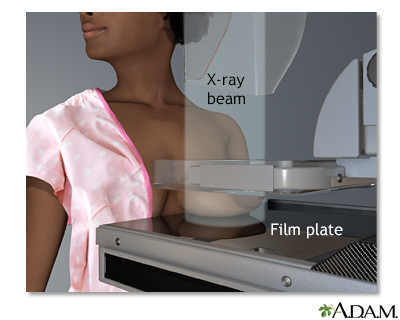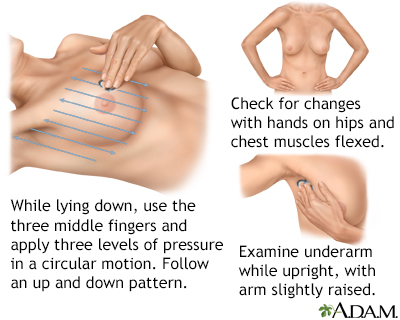Breast cancer screenings
Mammogram - breast cancer screening; Breast exam - breast cancer screening; MRI - breast cancer screening
Breast cancer screenings can help find breast cancer early, before you notice any symptoms. In many cases, finding breast cancer early makes it easier to treat or cure. But screenings also have risks, such as missing signs of cancer. When to start screenings may depend on your age and risk factors.

If you're a woman, your doctor or gynecologist may have recommended that you examine your breasts every month to check for lumps. You might be wondering, why do I need to do a breast self-exam? Or, you might ask, how do I examine my breasts, and what exactly am I looking for? Well, let's talk about why, and how to examine your breasts. Why examine your breasts? Well, for one thing, it helps you get an idea of how they normally feel. Then if there's ever a problem, you'll be familiar enough with your breasts to spot it. For example, a lump on your breast could be a sign of breast cancer. Finding that lump could allow you to get checked out with a mammogram earlier than you might have done if you didn't do breast self exams. But, this is a two edged sword. Many expert groups no longer recommend routine breast self examination because the consequences of over treatment of benign or normal lumps may outweigh the benefits of early detection. Lumps lead to extra mammograms, which often lead to biopsies, and the biopsies turn out to be benign, or normal, in more than 90% of cases. But, not always. Some expert groups simply recommend breast self awareness. Ultimately, the choice is yours. If you are going to do breast self exam, the best day to do a self exam is about 3 to 5 days after your period ends. Your breasts are naturally less lumpy right after your period, so there's less of a chance that you'll mistake a normal bump for an abnormal growth. If you've already gone through menopause and your periods have stopped, just do your exam on the same day every month. Mark it on your calendar so you won't forget. To do the exam, lie on your back, as it's easier to feel any lumps or changes when you're lying down. First, put your right hand behind your head. Then, using the middle fingers on your left hand, gently but firmly press down, circling your entire breast. Make sure you cover the whole right breast. Squeeze your nipple gently. See if any fluid comes out. Now, sit up, and feel around your armpit. When you're done with the right breast, repeat the whole check on the left side. Next, stand in front of a mirror. With your arms down at your sides, look at both breasts. Check the shape of each breast. Look for any changes in the skin, like dimpling or puckering. Also see if your nipples now turn inward. Now, do the exact same check again with your arms over your head. After you've done a few breast self-exams, you'll become familiar with the look and shape of your breasts. At each exam, you're looking for anything different, like new bumps, changes in the texture of your skin, or discharge from your nipple. If you do notice that something has changed, don't panic, it could mean many different things. But, call your doctor as soon as you can so you can find out what's caused the change, and, if necessary, get it treated.

The anatomy of the breast includes the lactiferous, or milk ducts, and the mammary lobules.

A mammogram is an x-ray picture of the breasts. It is used to find tumors and to help tell the difference between noncancerous (benign) and cancerous (malignant) disease. One breast at a time is rested on a flat surface that contains the x-ray plate. A device called a compressor is pressed firmly against the breast to help flatten out the breast tissue. Each breast is compressed horizontally, then obliquely and an x-ray is taken of each position.

Breast self-exams should always include a visual inspection, with and without a mirror, to note any changes in contour, texture, or color of the breast and nipple. Next, a manual inspection while standing or lying down should be done to note any unusual lumps or thicknesses and check for discharge.
Mammograms
A mammogram is the most common type of screening. It is an x-ray of the breasts using a special machine. This test is done in a hospital or clinic and only takes a few minutes. Mammograms can find tumors that are too small to feel.
Mammography is performed to screen women to detect early breast cancer when it is more likely to be cured. The recommendations of different expert organizations can differ.
- Mammography is generally recommended for all women starting at age 40, repeated every 1 to 2 years.
- Women with a family history of breast cancer should work with their health care provider to assess their risk of breast cancer. In some situations, additional testing may be considered.
Mammograms work best at finding breast cancer in women ages 40 to 74. It is not clear how well mammograms work at finding cancer in women age 75 and older.
Breast Exams
This is an exam to feel the breasts and underarms for lumps or unusual changes. Your provider may perform a clinical breast exam (CBE). You can also check your breasts on your own. This is called a breast self-exam (BSE). Doing self-exams may help you become more familiar with your breasts. This may make it easier to notice unusual breast changes.
Keep in mind that breast exams do not reduce the risk of dying from breast cancer. They also do not work as well as mammograms to find cancer. For this reason, you should not rely only on breast exams to screen for cancer.
Not all experts agree about when to have or start having breast exams. In fact, some groups do not recommend them at all. However, this does not mean you should not do or have breast exams. Some women prefer to have exams.
Talk with your provider about the benefits and risks for breast exams and if they are right for you.
If you're a woman, your doctor or gynecologist may have recommended that you examine your breasts every month to check for lumps. You might be wondering, why do I need to do a breast self-exam? Or, you might ask, how do I examine my breasts, and what exactly am I looking for? Well, let's talk about why, and how to examine your breasts. Why examine your breasts? Well, for one thing, it helps you get an idea of how they normally feel. Then if there's ever a problem, you'll be familiar enough with your breasts to spot it. For example, a lump on your breast could be a sign of breast cancer. Finding that lump could allow you to get checked out with a mammogram earlier than you might have done if you didn't do breast self exams. But, this is a two edged sword. Many expert groups no longer recommend routine breast self examination because the consequences of over treatment of benign or normal lumps may outweigh the benefits of early detection. Lumps lead to extra mammograms, which often lead to biopsies, and the biopsies turn out to be benign, or normal, in more than 90% of cases. But, not always. Some expert groups simply recommend breast self awareness. Ultimately, the choice is yours. If you are going to do breast self exam, the best day to do a self exam is about 3 to 5 days after your period ends. Your breasts are naturally less lumpy right after your period, so there's less of a chance that you'll mistake a normal bump for an abnormal growth. If you've already gone through menopause and your periods have stopped, just do your exam on the same day every month. Mark it on your calendar so you won't forget. To do the exam, lie on your back, as it's easier to feel any lumps or changes when you're lying down. First, put your right hand behind your head. Then, using the middle fingers on your left hand, gently but firmly press down, circling your entire breast. Make sure you cover the whole right breast. Squeeze your nipple gently. See if any fluid comes out. Now, sit up, and feel around your armpit. When you're done with the right breast, repeat the whole check on the left side. Next, stand in front of a mirror. With your arms down at your sides, look at both breasts. Check the shape of each breast. Look for any changes in the skin, like dimpling or puckering. Also see if your nipples now turn inward. Now, do the exact same check again with your arms over your head. After you've done a few breast self-exams, you'll become familiar with the look and shape of your breasts. At each exam, you're looking for anything different, like new bumps, changes in the texture of your skin, or discharge from your nipple. If you do notice that something has changed, don't panic, it could mean many different things. But, call your doctor as soon as you can so you can find out what's caused the change, and, if necessary, get it treated.
MRI (Magnetic Resonance Imaging)
An MRI uses powerful magnets and radio waves to find signs of cancer. This screening is done only for women who have a high risk for breast cancer.
Women at high risk for breast cancer (greater than 20% to 25% lifetime risk) should have an MRI along with a mammogram every year. You may have a high risk if you have:
- A family history of breast cancer, most often when your mother or sister had breast cancer at an early age
- Lifetime risk for breast cancer is 20% to 25% or higher
- Certain BRCA gene variations, whether you carry this marker or a first degree relative does and you have not been tested
- First degree relatives with certain genetic syndromes (Li-Fraumeni syndrome, Cowden and Bannayan-Riley-Ruvalcaba syndromes)
It is not clear how well MRIs work to find breast cancer. Although MRIs find more breast cancers than mammograms, they are also more likely to show signs of cancer when there is no cancer. This is called a false-positive result. For women who have had cancer in one breast, MRIs can be very helpful for finding hidden tumors in the other breast. You should do a MRI screening if you:
- Are at very high risk for breast cancer (those with a strong family history or genetic markers for breast cancer)
- Have very dense breast tissue
Benefits and Risks of Screenings
When and how often to have a breast cancer screening test is a choice you must make. Different expert groups do not fully agree on the best timing for screening.
Before having a mammogram, talk to your provider about the pros and cons. Ask about:
- Your risk for breast cancer.
- Whether screening decreases your chance of dying from breast cancer.
- Whether there is any harm from breast cancer screening, such as side effects from testing or overtreatment of cancer when it's discovered.
Risks of screenings can include:
- False-positive results. This occurs when a test shows cancer when there is none. This can lead to having more tests that also have risks. It can also cause anxiety. You may be more likely to have a false-positive result if you are younger, have a family history of breast cancer, have had breast biopsies in the past, or take hormones.
- False-negative results. These are tests that come back normal even though there is cancer. Women who have false-negative results do not know they have breast cancer and delay treatment.
- Exposure to radiation. Although the potential benefits of mammography outweigh the possible harm from the radiation exposure, repeated x-rays can cause cancer.
- Overtreatment. Mammograms and MRIs may find slow-growing cancers. These are cancers that may not shorten your life. At this time, it is not possible to know which cancers will grow and spread, so when cancer is found it is usually treated. Treatment can cause serious side effects.
References
Henry NL, Shah PD, Haider I, Freer PE, Jagsi R, Sabel MS. Cancer of the breast. In: Niederhuber JE, Armitage JO, Kastan MB, Doroshow JH, Tepper JE, eds. Abeloff's Clinical Oncology. 6th ed. Philadelphia, PA: Elsevier; 2020:chap 88.
National Cancer Institute website. Breast cancer screening (PDQ) - health professional version.
US Preventive Services Task Force, Nicholson WK, Silverstein M, et al. Screening for breast cancer: US Preventive Services Task Force recommendation statement. JAMA. 2024;331(22):1918-1930. PMID: 38687503
Version Info
Last reviewed on: 9/6/2024
Reviewed by: Warren Brenner, MD, Oncologist, Lynn Cancer Institute, Boca Raton, FL. Review provided by VeriMed Healthcare Network. Also reviewed by David C. Dugdale, MD, Medical Director, Brenda Conaway, Editorial Director, and the A.D.A.M. Editorial team.
